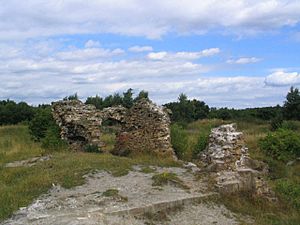Howley Hall facts for kids
Howley Hall is a cool ruined country house in West Yorkshire, England. It's located between the towns of Batley and Morley. This old building dates back to the Elizabethan era (that's when Queen Elizabeth I was in charge!).
Since 1997, Howley Hall has been a scheduled monument, which means it's a really important historical site that's protected. A man named Sir John Savile, who was a politician, built the hall in the late 1500s. His family owned it until 1671.
During the English Civil War in 1643, there was fighting at the hall. Later, the Brudenell family took over, but they didn't live there. Because no one was taking care of it, the hall slowly fell apart. It was eventually torn down between 1717 and 1730, leaving it as the ruins you can see today.
Contents
Howley Hall's Story
Building a Grand Home
Sir John Savile built Howley Hall, probably between 1585 and 1590. Sir John was an important politician in Yorkshire. He was part of a new group of leaders who became powerful after the English Reformation.
Like many people back then, he wanted to show his importance by building a really impressive country house. He hired a local architect named Abraham Ackroyd to design the hall. It was built in the Elizabethan style, which was popular at the time.
The Savile Family and War
The Savile family owned Howley Hall for almost 100 years. When Sir John died in 1630, his son, Thomas Savile, 1st Earl of Sussex, inherited it.
During the English Civil War (1642–1651), Lord Sussex couldn't decide if he supported the Royalists (who backed the King) or the Parliamentarians (who backed Parliament). He left Howley Hall in the care of his relative, Sir John Savile of Lupset, who was a Parliamentarian.
A Base During the Civil War
In May 1643, a Parliamentarian leader named Thomas Fairfax used Howley Hall as a base. From there, his forces successfully captured the town of Wakefield. This made the Royalist forces, led by the Earl of Newcastle, angry. They decided to attack Bradford in return.
To make sure the Parliamentarian soldiers at Howley Hall couldn't attack them from behind, Newcastle marched on the hall. After a short siege, Sir John of Lupset surrendered. Howley Hall then became Newcastle's base for the important Battle of Adwalton Moor. This battle, which was about 4.5 kilometers (2.8 miles) from Howley, gave the Royalists control of Yorkshire for a while.
The Hall's Decline
Many people in the area believe that Howley Hall was destroyed during the 1643 siege. However, it actually didn't get much damage. The hall was returned to the Savile family when Lord Sussex decided to support the Parliamentarians.
After he lost favor in 1646, Lord Sussex moved back to Howley Hall and added new parts to the building. In 1661, his son James Savile inherited the hall.
When James died in 1671 without children, Howley Hall went to the Brudenell family. James's sister, Frances, was married to the son of Robert Brudenell, 2nd Earl of Cardigan.
The hall probably started to fall apart around this time. Even though the Brudenell family owned it for 250 years, they didn't seem interested in living there. After James Savile died, the hall was rented out to three different families. By 1711, local people had even started taking stones from the hall to use in other buildings.
Records show that some of the hall's furniture was sold in 1719. Other items ended up in nearby buildings like the Chief Bailiff's House (which is now the Howley Hall Golf Club) and Thorpe Hall. To avoid paying for repairs, the Brudenell family finally had the buildings torn down with gunpowder between 1717 and 1730. This is why Howley Hall is in its ruined state today.


